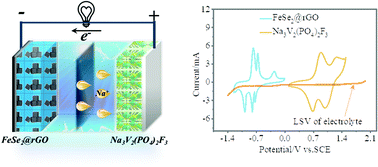Realizing an aqueous sodium-ion battery with a super-high discharge voltage based on a novel FeSe2@rGO anode
Abstract
Aqueous sodium-ion batteries (ASIBs) promise particularly increased operational safety and lower manufacturing cost than the current state-of-the-art organic electrolyte-based lithium-ion batteries. However, the output voltages of reported ASIBs are still restricted to under 1.5 V due to the generally high redox potentials of currently reported anode materials. In this work, we innovatively selected FeSe2 as the anode material for an ASIB to obtain a high output voltage. The electrochemistry of FeSe2 is demonstrated to be based on the reversible conversion reaction between FeSe2 and NaxFe2Se4/Na2Fe, while the inferior cycling stability is proved to be caused by the dissolution of the Na2Fe intermediate. By encapsulation of reduced graphene oxide, the capacity and cycling stability of FeSe2 have been improved, giving rise to a high capacity of 100 mA h g−1 and capacity retention of 72.2% after 100 cycles. Together with an elaborate aqueous/acetonitrile hybrid electrolyte and the Na3V2(PO4)2F3 cathode with a high redox potential, the as-assembled FeSe2@rGO//Na3V2(PO4)2F3 ASIB presents an excellent electrochemical performance in terms of a super high output voltage (∼1.7 V), high energy density (53.4 W h kg−1), and outstanding rate performance (78.2% retention rate at 5 A g−1).

- This article is part of the themed collections: Synthesis, modification and tailoring of properties of nanoporous materials and 2022 Inorganic Chemistry Frontiers HOT articles


 Please wait while we load your content...
Please wait while we load your content...